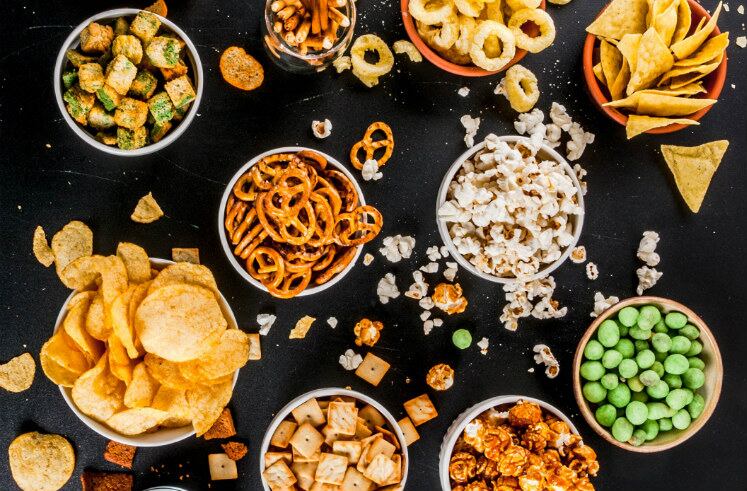“If the trends continue to hold, millennials are taking their snacking habits with them, creating a generation tailwind,” said Lyons Wyatt, executive VP and practice leader at IRI, referring to millennials aging into their 30s and 40s.
In its state of the industry report, IRI forecasted ‘more growth to come’ for the snacking segment – $16bn in the next five years – driven by the ubiquity of snacks and consumer interest in self-care.
Food and beverage is the third most important means of ‘holistic wellness,’ IRI found, ahead of exercise and sleep but behind personal care and healthcare.
The focus on self-care has coincided with a rise in snacking claims like kosher, gluten-free and no preservatives.
Just under half of consumers view snacks as an important aspect of a healthy eating plan. This perspective is more important to younger consumers than those over the age of 65, but Lyons Wyatt agreed that, generally, all generations believe snacks should satisfy a few key factors.
More than half of respondents want snacks that reach beyond basic nutrition, while 60% prefer fresh over processed and 73% look for ‘guaranteed fresh’ snacks.
‘Snacks are everywhere’
Once available predominantly in retail and convenience channel, snacks are now common sights in airlines, hotels, food trucks, fitness centers, and, of course, online.
Previously, consumers either planned on snacking or made an impulse purchase; today, however, they also look to snacks to satisfy on-demand or for a unique experience.
The plethora and diversity of options has led consumers to snack 2.7 times per day on average, an increase from the firm’s 2015 survey. In fact, 47% snack at least three times daily, and another 50% snack once or twice. Less than 5% of consumers say they never snack.
Still, Lyons Wyatt sees missed opportunities for brands to capitalize not only in what but also where and when consumers snack. Increasingly, consumers of all age groups are grabbing snacks from quick-service (QSR) and limited-service (LSR) restaurants.
IRI's Top 10 future snack trends
Tomorrow’s snacks will get more ‘tech-y,’ upcycled, a bit richer and more bitter.
- Conversation commerce: consumers will talk to gadgets to order snacks on demand
- Smart kitchens: refrigerated and frozen snacks will be automatically replenished
- Lab-grown protein: cell meat, plant-based or not, will permeate snacks
- Cannabis: will proliferate in baked goods
- CBD/hemp: already here, but expected to grow
- Ghee: will spread across the category, especially in nut-free spreads
- Butter: has found a new stride, similar to peanut butter last year
- Spent grains: leftover barley and wheat from brewing will lend their prebiotic fibers to crackers and snacks
- Bitter flavors: will grow in foodservice and snacking
- Technology: ‘inductive intelligence,’ such as a phone charger that acts as a portable microwave, will hit the market
‘You need to call that out’
The influx of dietary choices and restrictions, in conjunction with the broader better-for-you movement, has shifted what consumers look for on product packaging and messaging.
Lyons Watt said there is no one-size-fits-all solution as needs differ among generations.
Half of consumers prefer snacks to carry less sugar and salt, for instance, but those numbers creep closer to 60% for consumers over the age of 55.
IRI attributes that bump to a desire to curb disease and illness common with aging, but noted 45m consumers of all ages follow commercial diets such as Weight Watchers or self-subscribed diets, including flexitarian and vegan.
“That’s why there should be a variety of claims on your product because, again, of the difference in needs and desires,” said Lyons Wyatt.
Similarly, consumers are increasingly interested in supporting sustainable, transparent companies. Nearly 40% prefer snacks in slimmer packaging that is better for the environment or those produced through green manufacturing processes.
“Everyone should be ensuring that if you are having those practices, talk about them,” said Lyons Wyatt. “If you don’t have those practices, get going.”
Variety in style and size
IRI reported that in addition to convenience, consumers always want flavor.
“It is normally the number one answer of the survey,” said Lyons Watts, with 89% preferring to find their favorite flavor and 92% looking for enjoyable taste.
She added there are currently 4,160 flavor combinations in the macro-snacking universe, but only half saw growth in 2018 compared to the previous year.
The tiniest flavor tweak can make a world of difference, she said, highlighting the slew of cheese flavors and combinations, such as chicken and Monterey Jack (up 30%) or cheddar and sour cream (up 5%).
Peanut butter snacks are also up 15%, and chocolate duos have gained $30m in incremental growth. These ‘evolved fan favorites’ are succeeding, said Lyons Wyatt.
“Consumers want variety. That is what it is screaming.”

